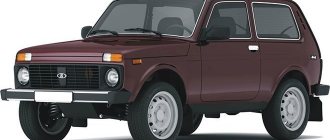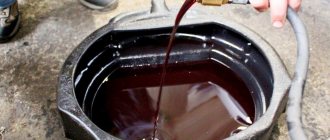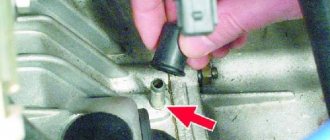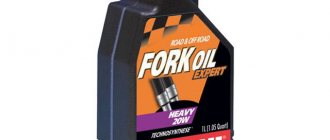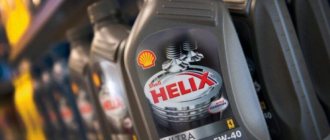What to consider when choosing oil for a pit bike
To choose the right liquid, several factors should be taken into account.
Engine type
Traditionally, such equipment uses 4-stroke engines with a volume of 50 to 165 cc/cm. but there are also two-stroke models. Depending on the type of power plant, the type of lubricant should be selected.
Manufacturer's recommendations
The most accurate factor is the manufacturer's tolerance. The motorcycle passport usually contains complete information about the viscosity, type and tolerances of the lubricant.
Season
Usually a pit bike is used in the summer. But there are some thrill-seekers who ride all year round. This is where nuances arise.
- In summer, when the temperature outside rises above +30 degrees Celsius, the standard viscosity (10W-40), recommended by most factories, is not relevant. The liquid begins to simply boil away from overheating. Here you should select lubricants with increased high-temperature viscosity.
- In the spring-autumn period, at air temperatures from +10 to +25, the most common viscosity for pita 10B-40 is useful. The motor will operate in nominal mode and without overheating.
- With the arrival of cold weather, you should definitely switch to less thick lubricants. In light frosts, you can use formulas like 5W-30, most common for scooters and mopeds. If the driver is completely extreme and drives in frosts worse than -10, it would not be a bad idea to use special oils for snowmobiles with a density of 0W
Tolerances and specifications
Typically, manufacturers recommend pouring oils from the API SJ group and similar ones into pit bikes. This is due to the simple design of the power plant and the absence of sophisticated exhaust cleaning systems.
There are also recommendations for lubricant base. In most cases, it is semi-synthetic, but mineral water should be poured into damaged engines due to its higher viscosity.
Oil viscosity by season
Quantity
So, we all know that oil has several types of viscosity and, probably, this is not just like that. But no one can be convinced, and everyone unanimously shouts “10 W 40!”, “Yes, that’s what it says in our technical book!”
You can listen to what you read now, or you may not... It’s up to you! And the damaged engine will be yours! But still, for novice pit bikers who want to be more or less literate, we will write everything as it is.
Let's start with the fact that everything written, every word was tested from our own experience: we have behind us more than one engine that has been damaged due to ignorance and stupidity, and far from being a Pitovsky one, the repair of which cost 60 thousand rubles more than once. Two Kab engines, similar to Pitov’s, were killed.
We can’t stop talking about your favorite technical book, which you read for God knows what. Well, excuse me, but you can take this book, crumple it up well and go sit on the throne.
Yes, indeed, it says that you need to use oil with a viscosity of 10W 40 and blah blah blah, BUT! Let's reveal the secret! This regulation is written for ideal operating conditions, a temperature of 20-25 degrees and a perfectly uniform seasonal climate!
Now look out the window and make sure that you live in RUSSIA, and not on sunny islands. There are already 4 seasons and even in the temperate zone the temperature difference is from +40 to -40.
Now let's look at what time of year, what oil is best to fill and at what ambient temperature.
SUMMER
Let's start naturally with the height of the season - summer. In the summer, especially in the central part of Russia, the temperature in the shade can go beyond 40 degrees, but in the sun it exceeds this mark and the air engine simply does not have enough oncoming flow of hot air to provide more or less normal cooling. High temperatures outside cause the engine to heat up much more, and your vaunted 10/40 begins to boil over! But this is half the trouble...
Boiling oil gradually evaporates, and judging by the number of breakdowns, you don’t like to keep an eye on the oil level. As a result, oil starvation and a dying piston and cylinder head.
Do you think that's all? But no, the funniest thing is happening with the clutch, which simply slips and burns due to the fact that in the crankcase you no longer have viscous oil, but a substance similar in viscosity to water.
Well, the last one is also quite funny - you stop forming a stable oil film on all parts, and this includes the crankshaft and the gearbox. The valve stem seals burn stupidly from running dry, and then you whine that your piston has run out, that the pit is smoking, and so on. Therefore, at this temperature, use oil with a viscosity of 20W/50 or 15W/50.
AUTUMN
Time passes, autumn is coming, the temperature outside is on average from 20 to 10 degrees, and now it’s time to start using 10W/40. Now it will be just perfect, the oil will hardly boil or evaporate much, the oil film will form very well, and you will not have any problems. The main thing is, don’t forget to keep an eye on the level and everything will be fine!
And yes, it doesn’t matter Motul, Castrol... Everything is mixed from one barrel and stamped under different brands and slightly different additives.
WINTER
With the onset of cold weather, it will be better to fill in oil with a viscosity of 5W/40. Usually it goes like a scoot. You can say that scooters have no gearbox, no clutch, blah blah blah, this oil is not suitable.
The only thing is that the composition of the scooter is 90% identical and has an almost identical series of additives injected into it. And yes, car oil really would not be suitable, since it is not designed for such high speeds. And the oil film simply would not stick to the parts.
What is the advantage of this oil? Yes, it simply has a lower viscosity, and nowhere in the oil channels will it form as dead jelly when it warms up, and the engine will not grind dry. Especially if your garage is not heated. In addition, of course, there will be no sticking of the clutch due to excessively thick oil. Again, talk will begin that the oil will heat up and the clutch will slip... Well, try it... But know that this oil can be used down to temperatures of minus 15 -20 degrees.
But in deep winter there are trash lovers who race in minus 25-35 degrees.
There are no options at all: you only need to fill in the zero, i.e. 0W/40. You won’t find this type of oil for motorcycles or scooters; it is used most often on snowmobiles, and that’s what we buy. The oil has a low viscosity at particularly low temperatures, so it can be used in an engine, at least with this oil change algorithm. The Kabovsky 110 engine has been alive for 260 hours and is still quite healthy and vigorous.
SPRING
By spring, when temperatures are already reaching plus 1, we pour 10W40 again, and then change according to the algorithm written above.
Result:
If you want to operate your pit bike in any weather conditions, then you should pay great attention to the correct selection of oil. Damaging an engine is a simple matter, but restoring it is time-consuming and expensive.
What oil is best to put in a pit bike?
Today, the pit bike has become almost the most popular vehicle among motorcycle equipment. They sell like hot cakes on the market. But there is no such equipment that you can just buy and ride all your life.
Pit bikes need timely maintenance, such as changing the engine oil. This procedure is very important, since the four-stroke engines produced today are more advanced and powerful than earlier models. Excess or lack of oil negatively affects the operation of the pit bike, so you must know the exact volume for the engine of a particular model. As a rule, this is 800-900 ml.
In order to change the engine oil, the first step is to unscrew and remove the dipstick, which also acts as a filler plug. This is necessary so that some air gets inside, which will make it easier for the oil to exit through the drain hole.
After this, you need to slightly unscrew the drain bolt, which is located at the bottom of the crankcase. This can be done with an open-end wrench size 17. The drain bolt is visible through the hole in the crankcase protection.
To pour or not to pour car engine oil into a motorcycle? Personal experience and laboratory analysis
What happens if you pour car engine oil into a motorcycle? Car oils are usually much more affordable than motorcycle oils. However, there are many opinions on this matter on online forums. Oil manufacturers advocate using only specialized oils, colorfully describing their benefits in advertising brochures, but without going into detail.
I filled my motorcycle with automotive engine oil, rode it 3,300 km and sent fresh and used oil to the laboratory. So I was able to understand how much the key parameters of the oil have deteriorated over a long run, how often it needs to be changed, and whether it’s worth getting involved with car oils at all or whether you’ll still have to trust the manufacturers.
There are many oils on the shelves with all sorts of marketing claims, but the most expensive is not always the best.
Content
- Synthetics, semi-synthetics and mineral water
- How often do you change the oil?
- Practice
- Laboratory test
- conclusions
The lubrication system in a motorcycle is different from a car, so the oil in them works under different conditions. On most motorcycles (but not all), the engine oil also services the transmission and clutch. These components require different properties from the oil, sometimes mutually exclusive. So, if friction-reducing additives are desirable for a cylinder-piston group (cylinder-piston group), then they will not be beneficial for a wet clutch. However, most automobile oils in the lower and middle price ranges do not have such additives and, according to this criterion, are suitable for motorcycles.
The red zone starts at 9.5 thousand rpm. By motorcycle standards, this is a medium-speed engine
Synthetics, semi-synthetics and mineral water
The division of oils into mineral, semi-synthetic and synthetic does not accurately reflect reality.
- In different countries, hydrocracked oils can be legally called either synthetic or semi-synthetic.
- According to the API (American Petroleum Institute) classification, base oils are divided not into 3, but into 5 different groups.
- The finished motor oil can consist of a mixture of two base oils of different categories and viscosity indices.
For example, a small proportion of PAO (API category 4, synthetics) and a very small proportion of esters (category 5, synthetics) are often added to hydrocracking motor oil (API category 3). Most likely, the packaging of such oil will say “Fully synthetic”, despite the fact that the hydrocracking base is made from crude oil. From different manufacturers (and in different price categories) it refers either to mineral water, or to semi-synthetics, or to full synthetics.
Now “synthetics” and “mineral water” have become more marketing terms than technical ones. It is much more useful for the buyer not to chase “synthetics”, but to choose an oil with a suitable viscosity index for your vehicle (and weather conditions), monitor the oil level and change it on time.
How often do you change the oil?
“Change your oil on time” usually means changing it twice as often as the specified service interval. For cars it is 15,000-20,000 km. For motorcycles, the 10,000 km interval specified in some manuals is also excessively long. Especially when it comes to operation in the city, where there are traffic jams, frequent acceleration and braking cycles, driving short distances on a not fully warmed-up engine, dust and reagents on the roads.
City driving = harsh operating conditions . With them, engine oil ages and loses its properties much faster. Therefore, many motorcyclists change their oil every 2,000-2,500 km.
But how justified is this? There is an opinion that in a car, over a long run, the viscosity of the oil begins to increase, and in a motorcycle, on the contrary, it begins to fall, as if the motorcycle transmission literally “grinds” the oil, lowering its viscosity. This opinion is also supported by reviews like “I filled up the oil, then after 7,000 km I drained the water.”
Practice
I bought a popular 10W-40 automotive motor oil and filled it in my Bajaj Pulsar NS200 motorcycle. in taking it for “arctic” frosts ( 5W -40, 0W -40): I don’t ride a motorcycle in sub-zero temperatures. And oil with a viscosity of 10W-40 will work reliably at both -10°C and -15°C.
The purchased oil complies with API SN, ACEA A3/B4 approvals, is suitable for both gasoline and diesel passenger engines, has a full package of additives (the most common additives, just in sufficient quantities) and good detergent properties, judging by the high alkaline number.
I specifically did not indicate the brand and type. There are many oils with a viscosity of 10W-40 and API SN, ACEA A3/B4 approvals, and most of them are inexpensive. They are produced with a full package of additives, which is determined by tolerances and not by a specific manufacturer. In this case, I used Castrol Magnatec 10W-40 A3/B4 API SN oil. Based on some indirect indications, I believe that it does not use a polymer thickener (or does use it, but in a minimal amount), but perhaps it is prone to varnishing over long runs. This is another reason to use flushes when changing the oil.
“On paper,” this oil should retain its properties over a longer mileage than similar ones with a reduced additive package, retain detergent and dispersant properties longer, and not lose viscosity longer. But the laboratory will show how it will actually be.
The oil level is closer to the upper limit of normal. The total volume of oil to be filled is 1.2 liters
I filled the oil on November 16, 2021, mothballing the motorcycle for the winter for three and a half months in an unheated garage. The season opened on March 4, and by mid-August I had driven 3,300 km. I drove both around the city and on the highway, the trips were both short and 400 km per day. And even (not) easy enduro on dusty, broken rural roads.
↑Video review of the Bajaj Pulsar NS200 motorcycle↑
The motorcycle is carburetor, single-cylinder, before the replacement it was driven on the same oil, but only 1,000 km. Before it, the first 5,000 km were driven by Motul 7100. It is curious that a liter of hydrocracked 10W-40 automobile oil turned out to be almost three times cheaper than Motul motorcycle oil. I was very interested in the question: would there be a noticeable difference in the behavior of the motorcycle when changing the oil?
Bad roads often lead to good places
I will say that in general the habits of the motorcycle have not changed. Gear shifting was clear and predictable, and remains so. Neutral is easy to catch. The idle speed after warming up is stable, the maximum speed has not changed. I have never had any “clutch slipping”, which is often feared on forums, in 3,300 km of driving. The engine sound may have become more high-pitched (but this is very subjective), but there are two reasons for this: I adjusted the valves at the same time as the oil change, and the viscosity changed from 10W-50 (more viscous) to 10W-40.
After 3,300 km, a small amount of metal shavings appeared on the coarse oil filter magnet (pictured). So, if you evaluate the performance of the oil only by the amount of chips on the magnet, then it protects the engine well. Previously, with a different oil, there were more chips, but then the motorcycle was run-in and the comparison is not very correct.
Collecting samples of fresh and used oil in special flasks for sending to the laboratory
Laboratory test
Results from the laboratory showed that in 3,300 km the oil went from viscosity class 10W-40 to class xxW-20. Viscosity dropped almost twofold at low temperatures (from 96 cCt to 56 cCt at 40°C) and by 34% at operating temperature (from 13.8 cCt to 9.1 cCt at 100°C). This is a significant drop, so it’s clearly not worth driving 5,000 km on such oil. Despite the decrease in oil viscosity, no increased wear is observed; all indicators from the laboratory are within normal limits. It is worth remembering that this is a 200 cc single-cylinder high-speed engine (cruising at 7-8 thousand rpm in 6th gear), the service life of which is lower than that of its large-capacity counterparts. Therefore, slightly increased values of wear metals in mining should not be alarming. Another thing is that in the oil system of my motorcycle there are two filters at once that catch a large proportion of wear particles (that’s how filters work). And the laboratory is looking for traces of these particles.
A PDF of the full lab report is available here.
The waste contains traces of coolant (sodium and potassium) and fuel (1.6%). Gasoline in oil has increased the drop in viscosity: it dilutes the oil and impairs its lubricating and protective properties. Unfortunately, this occurs on many motorcycles and further reduces oil life. The oil level visually remained at the same level throughout the entire mileage.
Most likely, there was more fuel in the oil than 1.6%. I poured the heated waste into an open, clean and new container, which remained open for another 10-15 minutes while the waste cooled, and I poured flush and then new oil into the motorcycle. After cooling, the waste was kept in a closed, airtight container for about three weeks. When I opened it, a strong, characteristic smell of gasoline appeared, which disappeared in a matter of seconds. So some of the gasoline may have evaporated from the oil before it was sent to the laboratory.
The alkalinity number of fresh oil decreased slightly in the spent oil (from 13.2 to 12.5 TBN). According to this parameter, the oil has a very large reserve of detergent properties. It seems that for motorcycles it is not necessary to look for oil with a high TBN, since it will sag only slightly. I note that the motorcycle was only refueled at branded gas stations with 95 gasoline and I have never seen 92 gasoline. A pleasant surprise was the presence of molybdenum in inexpensive motor oil. On the one hand, molybdenum reduces friction, which is not always good for motorcycles with wet clutches. On the other hand, molybdenum is found in many motorcycle oils, including Motul 7100.
conclusions
I came to the conclusion that it is possible to use automobile oil in a motorcycle if you follow the replacement schedule. I advise changing it at least every 2,000-2,500 km, as long as the viscosity drop is not too great. If your motorcycle tends to leak fuel into the oil, and you ride mostly around town (not on the highway), then it may be worth reducing the oil change interval to 1,500-2,000 km. The low price of automobile engine oil makes it possible to change it more often.
Laboratory services, in turn, are not cheap, but can help in diagnosing the problems of your two-wheeled friend.
What oil is best to put in a pit bike?
Today, the pit bike has become almost the most popular vehicle among motorcycle equipment. They sell like hot cakes on the market. But there is no such equipment that you can just buy and ride all your life.
Pit bikes need timely maintenance, such as changing the engine oil. This procedure is very important, since the four-stroke engines produced today are more advanced and powerful than earlier models. Excess or lack of oil negatively affects the operation of the pit bike, so you must know the exact volume for the engine of a particular model. As a rule, this is 800-900 ml.
In order to change the engine oil, the first step is to unscrew and remove the dipstick, which also acts as a filler plug. This is necessary so that some air gets inside, which will make it easier for the oil to exit through the drain hole.
After this, you need to slightly unscrew the drain bolt, which is located at the bottom of the crankcase. This can be done with an open-end wrench size 17. The drain bolt is visible through the hole in the crankcase protection.
Before completely removing the drain plug, it is better to place a 1-liter container under the engine. You can take a 5-liter water bottle with the neck cut off or a canister. The main thing is capacity.
Only after this can you unscrew the plug completely. During this time, try not to splash yourself with oil or drop any part such as a nut or bolt into it.
In this position, the pit bike should be left for half an hour so that all the used oil flows into the container without any residue. You can slightly rock the pit bike in different directions so that there is no oil left anywhere. By tilting the motorcycle to the sides several times, you can make sure that a lot of old oil remains on the walls. When the oil has been completely drained, the drain bolt can be replaced and tightened.
Which oil to choose is up to everyone to decide for themselves. For example, for highly accelerated engines it is best to use synthetic oil; for engines with high mileage, mineral oil is excellent because it provides a thick film layer and restores compression.
In general, the best option for pit bikes is semi-synthetic oil with a viscosity of 10W40. You should ask the manufacturer exactly how much to pour so as not to disrupt the operation of the engine. After the required amount of oil has been poured in, you need to insert the dipstick and plug into place without tightening it yet. You need to make sure that the motorcycle is level, without distortions, then remove the plug and dipstick. The correct oil level is in the middle of the ribbed surface. After this, you can tighten the plug with the dipstick completely and go for a ride. It must be said that after turning on the pit bike, the oil level will drop slightly, but this is normal, since it is evenly distributed throughout the crankcase.
And you definitely need to change the oil in a timely manner, forgetting that how long your pit bike will serve you largely depends on it.
Source
